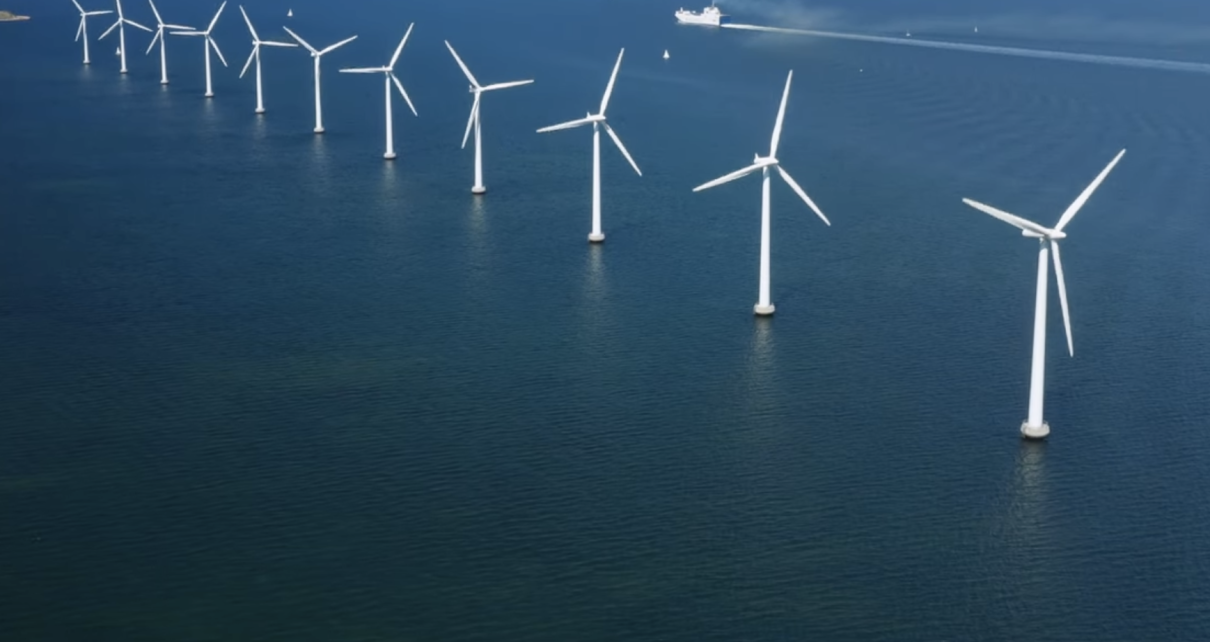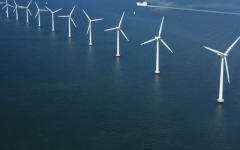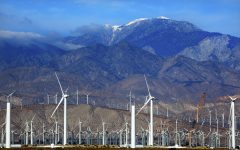
Offshore Wind farm. (Photo: Energy.ca.gov)
Ringside: The Cost of Offshore Wind vs Carbon Sequestration
If California goes all-electric, electricity consumption will need to triple
By Edward Ring, March 28, 2024 8:59 am
 The California Energy Commission (CEC) has set planning goals for floating offshore wind turbines, calling for between 2 and 5 gigawatts of “nameplate capacity” operating by 2030, and 25 gigawatts by 2045. Note “floating.” Unlike off the East Coast, or the North Sea, deep waters in California lie immediately offshore. So offshore wind in California aims to do at scale what has never been done before – deploy floating wind turbines 20 miles offshore, in 4,000 feet of water, to generate these gigawatts of electricity and send it ashore.
The California Energy Commission (CEC) has set planning goals for floating offshore wind turbines, calling for between 2 and 5 gigawatts of “nameplate capacity” operating by 2030, and 25 gigawatts by 2045. Note “floating.” Unlike off the East Coast, or the North Sea, deep waters in California lie immediately offshore. So offshore wind in California aims to do at scale what has never been done before – deploy floating wind turbines 20 miles offshore, in 4,000 feet of water, to generate these gigawatts of electricity and send it ashore.
How much will this cost?
Don’t expect much from the CEC’s 65 page, 26,000 word report, “Offshore Wind Energy Development off the California Coast,” issued in August 2022. Searching this PDF file for dollar signs turned up just 27 hits. In the Executive Summary, regarding costs, we get this: “Resource portfolio modeling completed for the 2021 SB 100 Joint Agency Report included a range of scenarios and technologies… The estimated total resource cost of the Core Scenario in 2045 is $66 billion.”
Turning to the “2021 SB 100 Joint Agency Report, Achieving 100 Percent Clean Electricity in California,” the diligent sleuth is invited to peruse the voluminous full report, or the summary, to track down any straightforward disclosure of construction cost to build this stuff. But never mind, because herewith is evidence that constructing 25 gigawatts of capacity will cost far more than $66 billion.
To estimate the cost for this project, we may turn to a document produced in 2021 by a consortium of some of the biggest offshore wind developers in the world titled “Guide to a Floating Offshore Wind Farm.” Within this report there is a chart of “Wind Farm Costs” with over 70 line items specifically called out, each one showing construction costs per megawatt.
To assess the credibility of this report, let’s consider a few facts before going further. The report is produced by BVG Associates, with offices in London, Glasgow, and Trondheim. They are renewable energy consultants with clients around the world. It is unlikely they will be overstating their cost estimates. We also know that since 2021, costs for offshore wind have gone up considerably. And we know that in California, not only are the challenges of floating offshore wind greater than usual because of the plan to float them in waters 4,000 feet deep and 20 miles offshore, but also because in California everything costs more to construct.
So based on BVG’s cost data, here is what is likely to be a best case estimate of what it would cost to install floating offshore wind turbines with 25 gigawatts of nameplate capacity. The construction costs per megawatt of capacity (in 2023 dollars) summarize as follows: $231,953 for “development and project management,” $2,010,261 for the wind turbine, $2,628,802 for the “balance of plant,” and $572,151 for installation and commissioning. That’s $5,443,167 per megawatt. Accordingly, to construct 25,000 megawatts (25 gigawatts) of offshore wind nameplate capacity, Californians will have to spend $136 billion. Add to that price estimate the billions necessary to build massive new transmission lines and gigawatts of new battery storage. A total project cost of “only” $150 billion would be an extraordinary achievement. Recent industry experience is not promising.
In just the last year, offshore wind developers have experienced cost overruns and had to abandon or resubmit bids on major projects along the U.S. East Coast as well as in the North Sea. Headlines from late last year and so far in 2024 tell a dismal story: “Wind Warning: Equinor, BP seek 54% hike in US offshore wind power price,” “U.S. Offshore Wind Projects Hit by Surging Costs,” “Another Offshore Wind Project Terminated Off Coast of New Jersey and New York,” “Offshore Wind in U.S. Is Fundamentally Broken,” “Equinor Abandons Offshore Wind Projects in Ireland,” and “Equinor calls halt to North Sea Trollvind project.”
If anyone, anywhere, wants to bet that 25 gigawatts of generating capacity can be realized in California — through the construction of giant floating wind turbines, onshore battery farms, and thousands of miles of high-voltage transmission lines both underwater and on land—for a total project construction cost of $150 billion, I’ll take that bet and give you odds. It is more likely the total project cost will soar beyond $300 billion. This is California, after all.
As for the amount of electricity we can expect from currently planned floating offshore wind in California, bear in mind “nameplate capacity” is not the same as “yield.” Even out in the windy open ocean these turbines are only expected to be turning 40-45 percent of the time. Also taking into account occasional downtime for maintenance, a 25 gigawatt capacity will only equate to 10 gigawatts of total power input to California’s grid, or 87,600 gigawatt-hours per year. For comparison, in 2022, Californians consumed a reported 287,220 gigawatt-hours of electricity. If California goes all-electric, which is the plan, electricity consumption will need to triple.
Here’s a prediction: Because floating offshore wind energy will prove to be prohibitively expensive, it will never provide more than a minute fraction of California’s electricity needs, but not before what does get built will make a grotesque mess of a coastline and coastal waters that state regulators have heretofore considered sacred.
Instead, why not just retrofit California’s natural gas powered electricity generating plants to capture and store their CO2 emissions underground? Based on data from the U.S. Dept. of Energy, these conversions would cost $44 billion (ref. WC #35). As it is, these plants produced 96,457 gigawatt-hours in 2022, fully 50 percent of California’s total in-state production. But for the most part, because of their allegedly dangerous emissions, they were only operated at 28 percent of their capacity, and only ran when solar and wind generated electricity was not available. If these plants were permitted to run at full capacity, they could have generated 345,573 gigawatt-hours, an increase of 249,116 gigawatt-hours.
If you were responsible for California’s economic health, which option would you choose?
(1) Retrofit California’s entire fleet of natural gas powered electricity generating plants to sequester their CO2 at a cost of $44 billion, in order to increase California’s in-state electricity generating capacity by 249,116 gigawatt-hours ($176,625 per gigawatt-hour), or,
(2) Install thousands of floating offshore wind turbines at a cost of $150 billion, plus the requisite new transmission lines and battery farms, in order to increase California’s in-state electricity generating capacity by 87,600 gigawatt-hours ($1,712,329 per gigawatt-hour).
While pondering this choice, think about which option is more likely to experience cost-overruns. It’s fair to expect both of these projects to end up with unanticipated costs. After all, this is California. But the engineering challenges inherent in CO2 sequestration are far better understood. And as it is, these baseline estimates of construction cost per gigawatt-hour show powerplant retrofits will cost less than one-tenth as much as floating offshore wind, which hasn’t even been prototyped at the scale and under the conditions being planned for California.
We may think whatever we wish regarding the necessity to engage in carbon sequestration schemes, but like offshore wind, it addresses the concerns of the climate lobby. California’s energy strategists need to think carefully before they take even one step further on offshore wind’s voyage into environmental desecration and financial oblivion.
- Ringside: Will the Delta Pumps Operate at Capacity this Winter? - December 18, 2025
- Ringside: Will Advocates for More Water Supply Projects Find Unity? - December 11, 2025
- Ringside: EVs and California’s Future Demand for Electricity - December 4, 2025





NO to floating offshore wind turbines! The Epoch Times last week reported in a story that some scientists are sounding alarms about the effects on cell and membrane structures of “infrasound” produced by wind turbine blades. When wind turbines rotate, however, they generate not only electricity but also infrasound. Infrasound is defined as a sound wave with a frequency of less than 20 hertz (Hz). The lower the frequency of the sound, the greater its wavelength and the harder it is to shield from it. Infrasound can penetrate walls, people, and animals.
Today’s wind turbines reach frequencies as low as 0.25 Hz. The wavelength of this frequency is just under 0.86 miles.
Infrasound has another special feature. Humans cannot usually hear frequencies below 16 Hz, which marks the so-called lower hearing threshold. In other words, we cannot hear many of the sounds emitted by wind turbines. However, we may feel them in our bodies as humming or rumbling, as with a loudspeaker. The lower the frequency, the higher the sound pressure level (i.e., the volume) must be to feel or hear it. The mechanical forces emanating from the inaudible sound frequencies can have an effect on the cell and membrane structures.
The consequences for humans and mammals such as whales are a lack of energy, chronic inflammation, disruption of reproduction, excess mortality, and population decline.
Yep – thank you for elucidating my initial thoughts so eloquently…
Do these a-holes even THINK for a second about the implications of all of their harebrained ideas for “clean” energy???
EVERY
SINGLE
ONE of them is insanely EXPENSIVE and ULTIMATELY MORE HARMFUL to the environment that they say is so precious to them….
What a nightmare. Another one! On every conceivable level.
You must factor in the real motives behind “green” when evaluating such technologies. Opportunities for graft is probably number one so the bigger the cost the more graft. Actual energy production is not a goal. In the case of wind it is to destroy wild life such as birds and whales. Energy production is purely a side effect. Just imagine what one good storm could do to one of these wind farms.
The CO2 sequestration is an incredibly bad idea. First of all it will be far more costly than stated. Second of all you must keep in mind “green” values which are no energy and no civilization, reducing plant growth to advance crop failure is another goal of theirs. Should someone be so foolish as to pursue such an idea the left will fall back on their proven strategy of moving the goal posts to achieve their real goals of collapsing the grid to accomplish their depopulation goals. To play along with people who have ulterior motives and lie about everything is a fools errand. No to both ideas. Natural gas energy is clean and so is nuclear. Use what is reliable and economical if you really want to advance energy production.
Is this author serious? Why is this even being discussed? Windmills are a multi-billion dollar, unworkable environmental nightmare. That’s been proven, I need not rehash what others have already done. We can dismiss carbon sequestration, and the entire “climate change” scam narrative that birthed it, by answering a few simple questions.
First, ask any botanist what happens to plants if CO2 levels fall below 175 ppm. The answer? They die. In fact, most plant life on Earth has evolved to tolerate levels above 2,000, and experience optimal growth rates at around 1,000 ppm. If normal levels are supposed to be below what they are today, around 400 ppm, why would plants have evolved in this way?
Second, what greenhouse ‘gas’ is both 300 times more effective as a greenhouse gas than CO2, and between 4 and 1,000 times more abundant in the atmosphere, depending on weather and time of day? Answer: water vapor. The sun and the oceans drive the Earth’s climate, not carbon dioxide. Humans do, indeed, alter regional short term weather patterns through the heat island effect and changes to the Earth’s albedo (replacing forest with farmland, etc.), and more recently the idiocy of geoengineering, but we do not have the capacity to alter our planet’s long term climate. Nature is still vastly more powerful than we are.
Carbon sequestration is just a very expensive way to cause earthquakes and poison aquifers. Discussing its benefits over wind turbines is the equivalent of arguing the benefits of shooting one’s self with a .44 rather than a 9mm.
This article is a bit like discussing how to “compromise” with the alligator that is eating you.
Here is the crux of the analysis:
If you were responsible for California’s economic health, which option would you choose?
(1) Retrofit California’s entire fleet of natural gas powered electricity generating plants to sequester their CO2 at a cost of $44 billion, in order to increase California’s in-state electricity generating capacity by 249,116 gigawatt-hours ($176,625 per gigawatt-hour), or,
(2) Install thousands of floating offshore wind turbines at a cost of $150 billion, plus the requisite new transmission lines and battery farms, in order to increase California’s in-state electricity generating capacity by 87,600 gigawatt-hours ($1,712,329 per gigawatt-hour).
Whether or not you think these projects are abominations – I am thoroughly convinced floating offshore wind is an abomination that must be stopped – it is important to view data like this. Of course the costs for CO2 sequestration will overrun estimates. But it is more than ten times as cost effective as floating offshore wind, for which costs will also overrun estimates. It is also less harmful to the environment, probably also by an order of magnitude. Furthermore, removing CO2 from flue gas is 100 times more cost effective than removing CO2 from the atmosphere to sequester it, which truly is a financial abomination, already receiving billions of dollars in federal subsidies.
Sequestering CO2 from already existing natural gas plants is something, just like nuclear power, for which environmentalist opposition only proves their hypocrisy and hidden agenda. For that reason alone, I think it is important to present this information. Do with it what you like.
Mr. Ring, no disrespect intended, far from it, but I think you’ve missed the point. Giant wind turbines and carbon sequestration are both fruits from the poisonous tree of the climate scam. Choosing one over the other is like choosing arsenic over cyanide because the former will take more time to kill us. If we absolutely must cater to the whims of the “Net Zero” fanatics, we need a choice C. Whatever happened to municipal anaerobic digestion of organic waste, such as grass clippings, food waste, etc. from households, farm waste, paper, etc.? If I recall correctly, less than ten years ago methane produced this way was the panacea for all of our environmental woes, according to the same people who are now crusading against natural gas (which is methane).
If we move forward with this junk it will be our economic Swan song. The last move of a failed culture. We no longer create the revenue for such wealth redistribution projects. Enough with the Dr. Suess kooky climate solutions!
If we move forward with this junk it will be our economic Swan song. The last move of a failed culture. We no longer create the revenue for such wealth redistribution projects. Enough with the Dr. Suess kooky climate solutions!
Just yesterday the Pacific Fisheries Council in conjunction with with a gaggle of other regulatory agencies cancelled the use of crab pots (for the second time) this season along the California coast. The stated reason is saving the whales. No crab pots for us but it’s ok to kill all the whales with offshore wind turbines because that’s “green.” It’s enough to gag a maggot.
Edward, stop being so logical…it upsets the liberals… 🙂